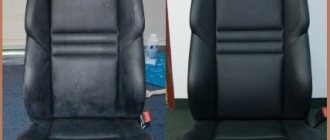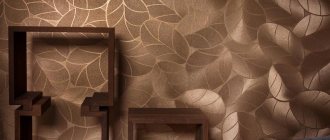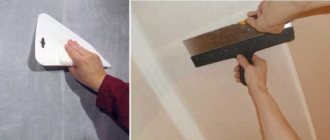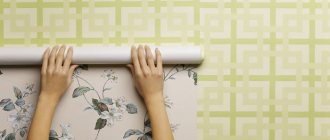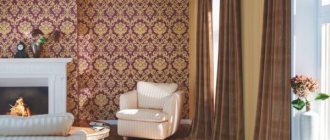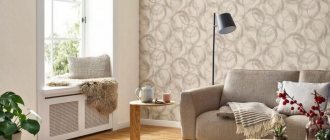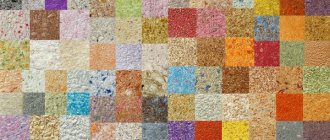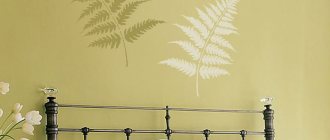When gluing wall coverings, some problems may arise. If the gluing technique has not been followed, damage may appear after some time.
They may also become dirty or have other types of defects. To avoid complete re-gluing due to one damaged sheet, you need to know how to correct defects. In the article we will tell you what types of defects there are, how you can hide seams and other defects with decorative elements, and also how to disguise overlaps.
Elimination of defects on walls. How to disguise wallpaper?
When gluing wall coverings, some problems may arise.
If the gluing technique has not been followed, damage may appear after some time. They may also become dirty or have other types of defects. To avoid complete re-gluing due to one damaged sheet, you need to know how to correct defects. In the article we will tell you what types of defects there are, how you can hide seams and other defects with decorative elements, and also how to disguise overlaps.
Butterflies that are trending right now
Rescue butterflies.
The most trendy solution in wall design for several years now has been butterflies. They can be anything: cut out of paper and bent in the center as voluminous butterflies, flocking together in a flock, three-de stickers, one-dimensional stickers - here the flight of imagination is truly endless. To ensure that no one guesses that you are masking pinpoint damage to the wallpaper, there should, of course, be several butterflies (at least three).
Types of defects
Defects occur under random circumstances or due to improper gluing technique; in any case, they look unpleasant and spoil the entire appearance. Unnoticeable stains or holes are usually not noticed immediately. But as soon as they are discovered, they should be removed immediately. To do this, it is not necessary to re-glue the entire canvas. It is enough to know certain methods to solve the problem.
Joints
Joints are vertical lines that highlight the edges of the canvas (how to join wallpaper correctly?). The reason for their appearance is incorrect gluing technique or incorrectly distributed glue on the wallpaper and wall. Often, defects lead to joints (how to repair wallpaper and joints if they have come apart?).
To avoid the appearance of joints between the wallpaper, it is enough to follow simple rules:
If the wallpaper is plain and the pattern is far from the edges, then you can solve the problem of joints with paint. When choosing paint, you should take into account its consistency with the colors of the wallpaper. Apply toner to the joint with a brush, and wipe the surface of the edges of the canvas with a napkin. The more patterns and details there are on the wallpaper, the more difficult it is to choose the right paint color.
There is a second way to fix joints:
Holes
If damage occurs in the form of holes, it is easy to fix. For this you need:
The patch should be fixed so that there is not even the slightest gap between it and the wallpaper.
If the hole is not in the wallpaper, but on the wall, then the correction scheme will be different:
Scratches and cracks
Scratches come in different sizes. The amount of work directly depends on this. If there are a lot of scratches over the entire surface of the canvas, then plywood would be the best option (how to glue wallpaper correctly?). And if the scratch is on one section of the wall, then it’s easier to fix it.
To work you will need:
Stains
Stains can be of organic or inorganic origin. There are many types of stains, but they can be corrected in many ways.
Stains can ruin the appearance of the apartment and need to be corrected immediately. There are greasy stains in every apartment. If there is wallpaper in the kitchen, then this kind of pollution will definitely appear. If grease appears on vinyl wallpaper, it will be easy to remove. Also, wallpaper based on non-woven fabric prevents fat from penetrating into the structure of the fabric. The water-repellent effect allows you to use detergents to remove stains.
There are several ways to get rid of grease on wallpaper:
Yellow spots may appear on wallpaper due to faulty water pipes. Often such spots appear on light-colored wallpaper. Such streaks on the walls give the impression of an uncleaned house. But you won’t be able to remove them using normal methods. They are either re-glued or the spots are decorated with various materials.
In the photo you can see how you can hide seams and other defects with decorative elements.
3. Makeshift art gallery
Why not an exhibition?
If your wallpaper has serious damage, and your budget temporarily does not allow you to re-paint the room, then you need to think about whether you have a friend who creates small watercolors for the table. Plan B is to visit an office supply or Chinese goods store. If your wall turns into an impromptu mini-gallery with reproductions or original watercolors, then you are guaranteed respect from guests and household members, and no one will ever know about the jambs on the wallpaper.
Masking the overlap
Before correcting the overlap, it is necessary to understand the nature of its occurrence. If an overlap appears after the wallpaper has dried, this means that the wallpaper took its original shape after applying the glue.
To remove the overlap, you need to do the following:
It is worth considering that these actions must be performed quickly. The glue sets quickly.
An overlap means that a mistake was made when gluing. More precisely, the canvas was not fixed in accordance with the level of the wall. The best way to get rid of overlap is to re-glue the fabric.
Game of contrasts
Before you decide to replace your wallpaper, think about your decor options.
A beautiful and effective decor is obtained by combining wallpaper of various contrasting shades. The decoration made with wallpaper of the same pattern, but in different colors, looks good.
It is best to choose the place for gluing contrasting stripes so that they frame or highlight the advantages of the furniture or room. For example, you can select an area for the location of a chest of drawers, a sofa or a bed. Or, marking the middle of the wall with colored stripes, decorate the decorated area with panels. photographs or small paintings.
To create such a decor you will need:
- a roll (or several) of wallpaper;
- wallpaper glue;
- brush;
- rubber roller for smoothing wallpaper;
- narrow stucco molding for framing (length equal to double the height of the ceilings);
- polyurethane glue;
- roulette;
- ladder.
It is very important to make symmetrical markings along the floor and ceiling lines before starting work. It is important to remember that the width of the area to be decorated must be a multiple of the width of the wallpaper roll!
To prevent your kitchen wall from being boring, use wallpaper with different textures or even patterns.
You can start gluing from any edge, carefully smoothing out air bubbles and avoiding distortions. Decorative stucco is glued to the sides after the wallpaper has dried, masking the junction of two colors. Polyurethane glue sets quickly, and the plank does not require additional fixation. This vertical division of the plane visually expands the space and creates a more comfortable environment.
Link to article
It is already difficult for many of us to imagine our life without a pet - a cat or a dog. The owners constantly take care of their pets and patiently endure their little pranks. For the time being, scratches on walls and furniture can be tolerated, but there comes a time when something needs to be done about it. Conversations for educational purposes help little here. Animals consider the interior of the apartment as their property and dispose of it according to their natural discretion. In search of protection for their home contents, pet owners are trying different finishing options. You can constantly replace torn wallpaper with new ones, or you can solve the problem radically and for a long time. But which is better? Let's look at the most accessible ways that you can do it yourself.
HOW DURABLE IS VINYL WALLPAPER?
This is the most inexpensive method available to each of us. But washable vinyl wallpapers vary in strength. There are loose coatings that can only cause destructive excitement, and such wallpaper will have to be changed often. But there is thick vinyl made using the silk-screen printing method. It can easily withstand frequent washing and is quite resistant to animal claws.
To the delight of dog and cat owners, vinyl anti-vandal wallpaper has appeared on sale. Their density is impressive: almost half a kilo per square meter. The dye of such wallpaper is not applied to the surface, but is introduced into the material. Small scratches on such a coating do not stand out in color and are almost invisible even at a distance of a meter. Manufacturers are going further, and vandal-proof wallpaper with additional polymer fiber reinforcement and a thin outer layer of especially durable vinyl on cotton fabric protected by a layer of Teflon is already on sale. Even the most aggressive dyes are easily washed off from such a film. Space technologies can make the lives of animals more comfortable and people kinder.
GLASS WALLPAPERS ARE MUCH STRONGER
This is indeed true and the main thing is that this is the most budget option according to reviews from those who followed the path of trial and error. Fiberglass wallpapers are available in different patterns and densities. To solve the problem, it is not at all necessary to use the heaviest ones. You should also refrain from purchasing canvas with rough relief; cats are especially interested in it. Gluing such wallpaper is not difficult, but requires some care in handling as with any fiberglass. The adhesive is used with a special formula, specifically for glass wallpaper, which can hold the weight of the coating and give it additional strength. After painting with washable water-dispersed acrylates, such a surface becomes completely uninteresting for dogs and cats. Fiberglass wallpaper is also good because it can be periodically repainted in new color shades.
PAINTED WALLS – A SIMPLE SOLUTION
If you're willing to put in a little work to keep your home interiors looking beautiful for a long time, then painting the walls may be the right option. This solution has the circumstance that the base must be carefully prepared for painting. You will have to work hard to bring the surface of the walls to an ideal smooth state. Plaster, primer, putty and primer again before applying the topcoat. These labor-intensive operations can be significantly simplified if you decide to use textured paint or textured plaster. The resistance of such coatings to claws is beyond doubt, and you can complete the necessary work much faster.
RELIABLE CERAMIC TILES
It can indeed guarantee maximum protection for walls, but many of us have the impression that this material is only suitable for bathrooms and kitchens. A careful acquaintance with the Castorama assortment will help you get rid of misconceptions. You will see new collections that are most suitable for the interiors of your hallway and corridors. Pay attention to porcelain tiles with an interesting pattern of natural stone. It looks good on facades and can become a worthy decoration inside your home. There are attractive tile designs that imitate neat brickwork or precious wood panels.
It must be said that when choosing any of the options, it is not at all necessary to make a vandal-proof coating right up to the ceiling. The zone of active destruction usually ends a meter from the floor level, and you can protect this lower part of the wall reliably, and in the upper part apply other coatings that are dear to your heart.
PANELS – DECORATION AND PROTECTION
Protecting walls with panels is usually the first experience for pet owners. The variety of colors and patterns of PVC panels has reached the level where choosing the right one is no longer difficult. However, everything is not so simple here. Plastic panels have a honeycomb structure and transverse stiffeners. This hardness is sufficient for gentle handling, but large dogs can easily damage the coating. Panels become especially vulnerable to damage if they are installed on sheathing. It is better to stick them directly to the wall using Liquid Nails adhesives.
The cat is tearing the wallpaper, the cat is scratching the furniture - what to do?
Before you bring a kitten into your home, you need to think about everything several times. After all, most often cats end up in a shelter or on the street due to the fact that they do not meet the owner’s expectations - they damage furniture and wallpaper. The cat not only enjoys scratching and tearing decoration and interior items, it is vital for him. But what should the owner do if he likes both the cat and the renovations in his own home?
How to stop a cat from tearing up wallpaper and interior items, and whether this should be done in principle - these problems are discussed in detail in this article.
Cheap but stylish piping
Who will understand that this is a disguise for a joint?
Has your little kitten decided to check what will happen if you pick at the wall with a tiny claw? Did you learn to ride a hoverboard at home in your room before going out in style in public and crashed into a wall? No problem! A penny paper wallpaper edging will come to the rescue. It sticks to regular PVA or wallpaper glue without any problems or streaks. And none of your guests will subsequently be able to prove that this beautiful matching stripe is masking something. It’s just that you are a creative owner and know a lot about interior design!
Is it possible to prohibit a cat from sharpening its claws?
The listed factors that explain the cat’s behavior indicate that by prohibiting the animal from sharpening its claws, one can cause psychological and physical harm to it.
You can somewhat reduce the cat’s need for this procedure by giving him a timely “manicure.” Claws need to be trimmed only with special scissors for cats.
Important! Dog manicure tools are not suitable for a kitten - these animals have different nail shapes and structures.
You need to do a “manicure” with extreme caution - there is a blood vessel in a kitten’s claw, which, if damaged, can cause severe bleeding. You can only cut off the transparent part of the claw, without reaching the white matte area. This must be done with special scissors, maintaining a certain angle.
To avoid injuring the kitten, it is better to do the first few procedures at a veterinary clinic. After the procedure, the pet should be praised and given something tasty, because claw trimming is a strong psychological trauma for the animal.
Attention! There is an operation in which one phalanx of each finger is removed from the cat along with the claw. This procedure is prohibited in many countries of the world due to inhumane treatment of animals. Such an operation can greatly harm a cat and cause many disorders (for example, involuntary urination).
It is necessary to prohibit a kitten from sharpening its claws only until it begins to do so. The animal will not understand why it is being scolded if more than a few minutes have passed since the “crime” was committed.
The owner of a cat must understand that it cannot avoid sharpening its claws at all - this is harmful for the animal. A person’s goal is to teach a cat to tear only those objects that can thereby protect furniture and wallpaper.
Fighting the edges that have risen up like a house
Not the most difficult, but quite common case when joints rise and twist, photo. Usually craftsmen in such a situation, in order to hide their imperfections, blame the quality of the wallpaper and poor glue. In fact, the problem lies precisely in the lack of professionalism of the workers. In the process of coating the cloth, experienced craftsmen apply glue to the edges twice, because the adhesive mass dries much faster along the edge of the cloth. To hide the raised joints, just apply an additional layer of adhesive under the seam line and roll the trellis with a rubber roller.
How to glue loose wallpaper joints?
If the edges of the wallpaper come off, you just need to re-glue the joints. This is the simplest problem and you need to proceed in the same way as during repair. You need to make sure that there is no debris on the peeled edges. To glue up loose wallpaper, use only wallpaper glue that you have tested, but make it more liquid.
Interesting materials:
Where did the Count of Montecristo sit? Where do the horses gallop? Where to tell the sergeant that you want to take away the mind? Where is Skellige The Witcher 3? Where can I copy the link to the YouTube channel? Where do they serve in the Airborne Forces? Where did Nikita Mikhalkov's uncle serve? Where did Archpriest Smirnov serve? Where can I see Oriflame's income? Where can I watch OGE 2022 results?
How to protect your interior from cat claws
To prevent a cat from tearing up your favorite sofa or new wallpaper, you need to act with cunning and affection. Scolding and punishing your pet for a damaged interior will not achieve the desired effect. Cats are very freedom-loving and willful; you cannot act “head-on” with them.
Everything needs to be done gradually, for every correct step the cat should be praised and rewarded with treats. A cat will not tear or tear objects if they are protected in a special way:
If humane methods do not help, you can use “heavy artillery”:
Advice! It is very important that the cat understands why he is being punished. Therefore, it is necessary to use water or a rattle only when he has already begun to tear furniture or walls with his claws.
How to accustom an animal to a scratching post
The salvation of many owners is a scratching post. You can make this item yourself or purchase it at a pet store. Most often, scratching posts consist of a solid frame of arbitrary shape and a top layer. It is the top layer that should attract the cat’s attention; it is made as interesting as possible for the animal.
The structure of this material should resemble the tree bark on which cats sharpen their claws in natural conditions. You can use carpet, sisal, upholstery fabric for furniture, or wrap twine around the scratching post.
When accustoming a cat to a scratching post, you need to follow a number of rules:
Decorating wallpaper for painting
Fiberglass and non-woven wallpaper have an interesting feature - they can be painted. In this case, you do not need to specifically time the repair to change the boring color of the wall coverings; the effect can be achieved without removing them.
How to decorate wallpaper for painting
However, you should start by gluing wallpaper. An interesting effect can be obtained by painting walls or canvas from the reverse side, when the paint begins to show through the non-woven material. Combined with a relief surface, this will enhance the wall decor.
At the same time, remember, if painted:
You can significantly highlight the texture of the coating by using different colors for the depressions and protruding parts.
You can do this in two ways:
Decor options
When painting wallpaper, you can use the most unexpected methods.
How to decorate old wallpaper yourself
Unusual way
If there is a hole in plain wallpaper with a recess, for example, from a self-tapping screw, you can try an unusual method. As you know, children's modeling clay comes in a variety of colors. It molds well and becomes very hard when dry. We select a suitable color and fill the hole with modeling material. It will dry out and remain in the hole until the next repair. If the color is not suitable, you can try to tint the mass with acrylic paints after drying.
There are probably many ways to fix this problem. With the advent of the Internet, netizens are happy to share unusual solutions. I wonder how you solve this difficult problem?
How to save already damaged items
Most often, the owner cannot predict the behavior of his pet. The result is furniture with snags and holes, tattered wallpaper on the corners and damaged carpets.
You can try to fix everything:
If a cat has torn off the furniture, this is not a reason to send it outside. We are responsible for those we have tamed, so we must re-educate the animal, and not get rid of it. To prevent wallpaper from becoming the only way for a cat to sharpen its claws, you need to prepare a special scratching post for your pet. And it’s better to do this right away, when the kitten first gets into the house, so that he gradually gets used to the scratching post, because cats don’t like new objects and treat them with distrust.
We decorate walls with wallpaper and other materials
In addition, other combinations of materials are often used, which makes it possible to expand the spheres of influence of each of them. Everything, of course, depends on imagination, and today there are plenty of materials for its implementation.
You can combine with each other, for example:
Recommendations
How to decorate peeled wallpaper using artificial stone
Tip: if you don’t have enough energy in the room, use combinations of colors located in opposite sectors.
Decor rules
When using a combination of wallpaper in the interior, you should not forget about the rule - they must have design elements that echo each other. These can be shades of the same color or a single design style.
For example, floral patterns go well with wooden patterns, and abstraction goes well with any geometric shapes. When choosing a certain interior style, it is best to create a border between the wallpaper using decorative polyurethane pilasters, painted in the desired color, or wooden planks, for example, halves of bamboo stems.
Advice: when choosing a method for decorating a room, remember that any combination of wallpaper should not stand out from the general style of the room, be a continuation of its purpose and reflect its specifics. Then the design of the room used will be harmonious and not irritate those living in the apartment or house.
Source
